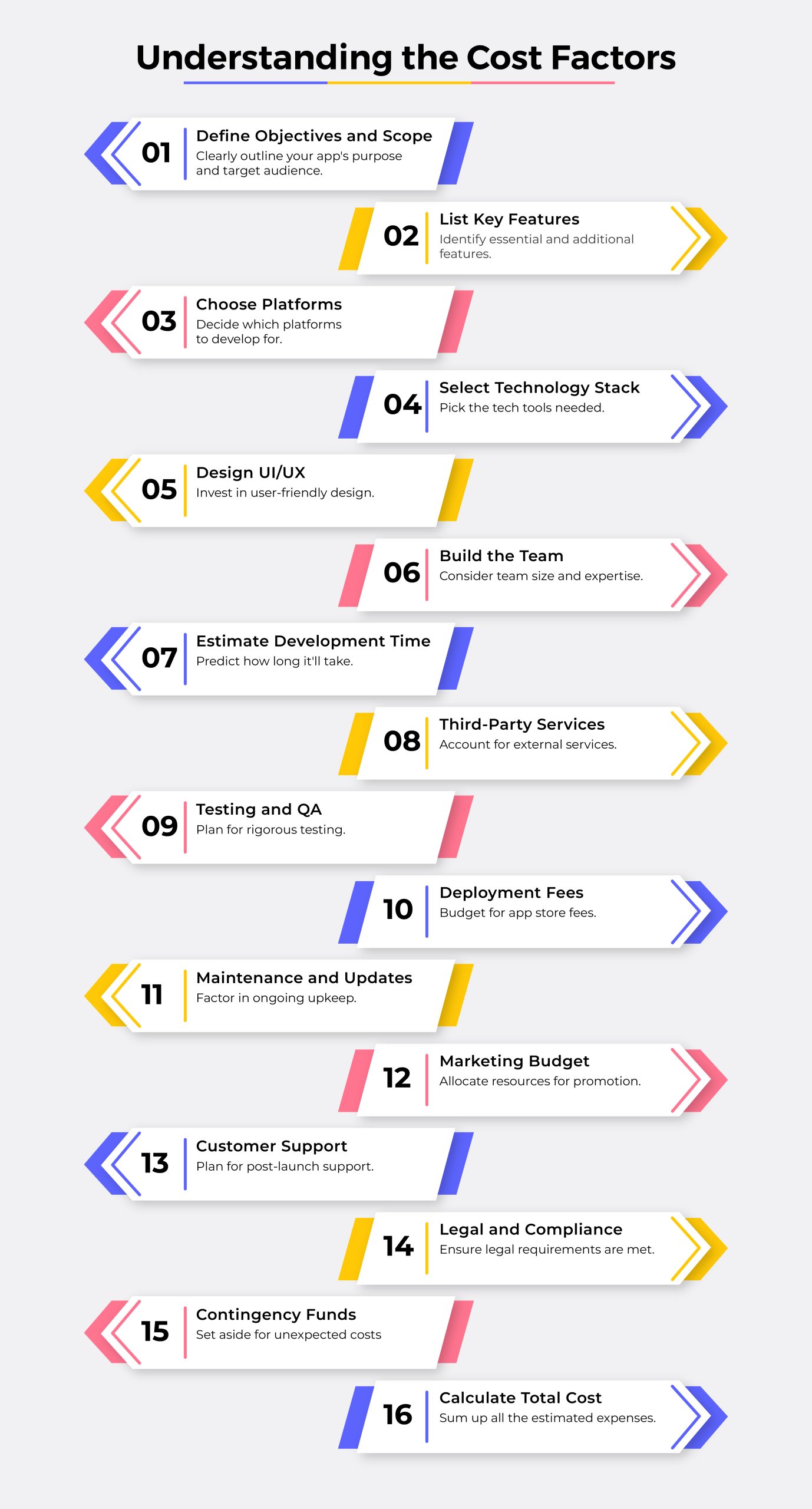Introduction
Building an app is like opening a digital portal to your business in current times. It’s a gateway to the digital world, a means of communication, and a stage for participation. However, “How much does it cost to build an app?”many find it confusing and important. In this detailed tutorial, we will explore the topic of app development team cost in great detail, dissecting each part to provide you with an accurate image.

Understanding the Cost Factors
App development is not just about coding; it’s about bringing a digital vision to life. The cost of building an app is influenced by several factors, which we will explore below.
Scope and Complexity
- Simple Apps: These are basic apps with fundamental features.
- Moderate Complexity Apps: These apps have more advanced features like real-time chat or a payment gateway.
- Highly Complex Apps: Think of apps like Uber or Airbnb. They require advanced features, such as geo-location services and third-party integrations.
Platform Choice
- iOS: Known for its strict development environment but offers access to a premium user base.
- Android: Boasts a larger user base and a more flexible development environment.
- Cross-Platform: A blend of both worlds, but with its own set of complexities.
Design and User Experience
- User Interface (UI): The look of your app.
- User Experience (UX): How the user interacts with your app.
Development Team Location and Size
- Location: Rates vary significantly across different regions.
- Team Size: More members mean more specialties but increased costs.
The Impact of Development Methodologies on Cost
When diving into the world of app development, one aspect that significantly influences the cost, yet often goes under the radar, is the choice of development methodology. This choice can shape the entire trajectory of your project, impacting not just the cost but also the quality and timeline of your app.
Understanding Development Methodologies
Firstly, let’s understand what a development methodology is. In simple terms, it’s a framework used to structure, plan, and control the process of developing an information system. Here are the two most commonly used methodologies in app development:
Agile Methodology
- Characteristics: Agile is all about flexibility and iterative progress. This methodology breaks the project into small, manageable chunks, known as sprints.
- Ideal For: Projects where requirements are expected to evolve over time.
Waterfall Methodology
- Characteristics: The Waterfall methodology is a linear and sequential approach. Here, each phase of the project must be completed before the next begins, with little room for changes once a stage is completed.
- Ideal For: Projects with well-defined requirements and where changes are unlikely to occur during development.
Comparing the Costs
Each methodology carries its unique cost dynamics:
- Agile’s Flexibility: Agile’s iterative nature allows for frequent reassessment of the project’s direction, which can be a double-edged sword. While it enables continuous improvement, it can also lead to scope creep – where the project expands beyond its initial projections, potentially increasing costs.
- Waterfall’s Predictability: Waterfall’s structured approach provides a clear picture of the project’s trajectory, making it easier to estimate costs upfront. However, this method can become expensive if significant changes are required after the project has advanced past the planning stages.
Balancing Methodology with Budget
Selecting the right development methodology requires a careful balance between your project needs and budget constraints. Here are some tips to align your choice with your budget:
- Clearly Define Requirements: Understanding your project’s requirements upfront can help in choosing the most cost-effective methodology.
- Be Prepared for Change: If you anticipate changes during the development process, Agile might be a more suitable and cost-effective choice.
- Consider the Long-Term Perspective: Evaluate how your choice of methodology will impact not just the initial development cost but also future updates and maintenance.
The App Development Team: Roles and Responsibilities
When you’re investing in app development, you’re not just paying for code; you’re paying for the expertise and efforts of a team. Let’s meet the team members.
The Core Team
- Project Manager: The orchestrator of the app development process.
- UI/UX Designer: Crafts the visual and interactive aspects of your app.
- Developers: The builders – iOS, Android, or Full-stack.
- Quality Assurance Engineer: Ensures the app is bug-free and user-friendly.
The Extended Team
- Business Analyst: Helps in aligning your app with business goals.
- Backend Developers: Manages the server, database, and application logic.
- Marketing Specialist: Crafts strategies to make your app stand out.
Breaking Down the Costs
Let’s take a look at the cost structure in a more detailed manner.
| Development Stage |
Estimated Cost Range |
| Concept & Planning |
$1,000 – $5,000 |
| Design Phase |
$5,000 – $15,000 |
| Development Phase |
$10,000 – $80,000 |
| Testing & Deployment |
$5,000 – $10,000 |
| Maintenance |
$500 – $5,000/month |
The Influence of Development Regions on Costs
The geographical location of your app development team can significantly impact the overall cost.
- North America: Known for high-quality standards but comes with a higher price tag.
- Eastern Europe: Offers a balance of quality and affordability.
- Asia: Generally the most cost-effective, but be mindful of potential communication and time zone challenges.
Saving Costs without Compromising Quality
Yes, building an app is expensive, but there are ways to optimize your expenditure.
Smart Planning
- Define Your MVP: Start with a Minimum Viable Product to test the waters.
- Prioritize Features: Not every feature needs to be part of the initial launch.
Choosing the Right Team
- Freelancers vs. Agencies: Freelancers might be cheaper, but agencies offer a more comprehensive skill set.
- Outsourcing: Consider outsourcing to regions with lower development costs.
Future Costs: Beyond Development
App development doesn’t end at launch. There are ongoing costs to consider.
- Maintenance: Regular updates, bug fixes, and server costs.
- Marketing: To make your app visible in a crowded marketplace.
- Legal Compliance: Ensuring your app meets all legal requirements.
Post-Launch Expenses and Revenue Models
The process does not end once your application goes live. Partnering with a skilled mobile app development company can be invaluable in understanding and planning for post-launch expenses, which is crucial for the sustained success and growth of your app. Simultaneously, exploring various revenue models with the insights from a seasoned mobile app development company can ensure your app not only sustains itself but also becomes a profitable venture.
Navigating Post-Launch Expenses
Post-launch, several ongoing costs need to be considered:
Maintenance and Updates
- Routine Maintenance: This includes fixing bugs, updating software libraries, and ensuring compatibility with new operating system versions.
- Cost Implication: Regular maintenance is essential to keep your app functioning smoothly and can vary from minimal to substantial expenses depending on the complexity of the app.
Customer Support
- Responsive Support: Providing users with a way to report issues and seek help improves user satisfaction.
- Cost Implication: Depending on the volume of users and the nature of the app, customer support can be a significant ongoing expense.
Marketing and User Acquisition
- Continuous Marketing: To keep your app visible in a crowded market, ongoing marketing efforts are essential.
- Cost Implication: Marketing costs can vary widely but are crucial for growth and should be factored into the budget.
Legal Compliance
- Regulatory Compliance: Keeping up with legal requirements, especially if your app deals with sensitive user data, is non-negotiable.
- Cost Implication: Legal compliance can incur costs, especially if the regulations change and the app needs to be adjusted accordingly.
Exploring Revenue Models
To offset these ongoing costs, it’s important to have a solid revenue model in place. Here are some of the most popular revenue models for apps:
In-App Purchases
- Description: Users pay for virtual goods or additional features within the app.
- Suitability: Ideal for games and apps offering premium functionalities.
Subscription Model
- Description: Users pay a recurring fee to access the app or premium features.
- Suitability: Best for service-oriented apps, like streaming services or productivity tools.
Advertising
- Description: Generating revenue through displaying ads to the app users.
- Suitability: Suitable for apps with a high volume of users where user experience isn’t heavily compromised by ads.
Freemium Model
- Description: Offering a free version of the app with limited features and charging for an upgraded version.
- Suitability: Effective for apps where the free version entices users to upgrade for more features.
Sponsorship and Partnerships
- Description: Partnering with other brands to offer content, services, or features within your app.
- Suitability: Ideal for apps with a specific niche audience that attracts partnering brands.
Balancing Expenses with Revenue
The key to a successful app is finding the right balance between managing post-launch expenses and generating revenue. This involves:
- Strategic Planning: Carefully planning your post-launch budget and aligning it with your revenue model.
- User Feedback: Continuously iterating based on user feedback can help in optimizing both the costs and the revenue streams.
- Market Analysis: Keeping an eye on market trends and adapting your app’s revenue model as necessary.
Frequently Asked Questions
The average time to create an app is what?
It can range from a few months to over a year, depending on complexity.
Is it cheaper to build a web app instead of a mobile app?
Generally, yes. Web apps tend to be less complex and require fewer resources.
Can I build an app by myself?
If you have the necessary skills, yes. However, it’s a time-consuming and complex process.
How do I protect my app idea?
Consider NDAs and intellectual property rights before sharing your idea.
Will I need to update my app regularly?
Yes, regular updates are crucial for security, user experience, and compatibility.
Conclusion
The journey to app development is filled with choices, challenges, and costs. By understanding the intricacies of app development team costs, and potentially partnering with a reliable mobile app development company, you can make informed decisions and invest wisely in your digital dream. Remember, the right investment in your app, guided by the expertise of a professional mobile app development company, can propel your business to new heights.






